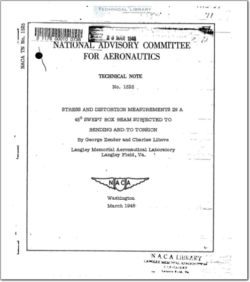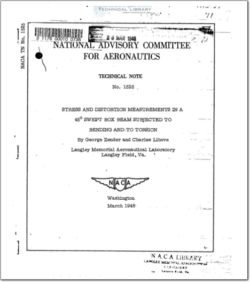NACA-TN-1525

- Version
- 187 Downloads
- 1.04 MB File Size
- 1 File Count
- December 4, 2015 Create Date
- December 4, 2015 Last Updated
National Advisory Committee for Aeronautics, Technical Notes - Stress and Distortion Measurements in a 45deg Swept Box Beam Subjected to Bending and Torsion

An untapered aluminum—alloy box beam, representing the main
structural comenent of a full—span, two—spar, 115° ewe t wing with a
carry—through bay, was subjected to tip bending and twisting loads
and its stresses and distortions were measured. Only symmetrical
loading was considered and the stresses were kept below the propor-
tional limit.
The investigation revealed that for bending the important
effect of sweep was to cause a considerable build—up of normal stress
and vertical shear stress in the rear spar (when co idering the box
beam as sweptback) near the fuselage. No such marke effect
accompanied torsion. The stresses in the outer portions bf the
box, both in bending and in torsion, appeared to be unaffected by
sweep and agreed fairly well with the stresses given by elementary
beam formulas.
The investigation further revealed that the spar deflections of
the swept box beam could be estimated approximately by analyzing the
outer portions of the box beam as ordinary cantilevers and making
adjustments for the flexibility of the inboard portion to which the
cantilevers are Joined.
Present designs of aircraft for transonic speeds call for wings
with large angles of sweep. In order to study the structural problems
encountered in the design of swept wings a 15° swept box beam, shown
in figures 1 and 2, was subjected to symmetrical tip loading and its
stresses and distortions were measured. This paper gives the
measured data and compares the stresses with those given by standard
beam formulas and the distortions with those estimated on the basis of
approximate calculations.
| File | Action |
|---|---|
| naca-tn-1525.pdf | Download |

Comment On This Post